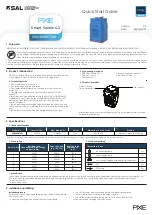
Chapter 21 Multicast
GS1350 Series User’s Guide
173
Report Proxy
Select this option to allow the Switch to act as the IGMP report proxy and leave proxy. It will
report group changes to a connected multicast router.
The Switch not only checks IGMP packets between multicast routers or switches and multicast
hosts to learn the multicast group membership, but also replaces the source MAC address in
an IGMP v1/v2 report with its own MAC address before forwarding to the multicast router or
switch. When the Switch receives more than one IGMP v1/v2 join report that requests to join
the same multicast group, it only sends a new join report with its MAC address. This helps
reduce the number of multicast join reports passed to the multicast router or switch.
The Switch sends a leave message with its MAC address to the multicast router or switch only
when it receives the leave message from the last host in a multicast group.
Host Timeout
Specify the time (from 1 to 16711450) in seconds that elapses before the Switch removes an
IGMP group membership entry if it does not receive report messages from the port.
802.1p Priority
Select a priority level (0 – 7) to which the Switch changes the priority in outgoing IGMP control
packets. Otherwise, select
No-Change
to not replace the priority.
Unknown Multicast
Frame
Specify the action to perform when the Switch receives an unknown multicast frame. Select
Drop
to discard the frames. Select
Flooding
to send the frames to all ports.
Reserved Multicast
Group
The IP address range of 224.0.0.0 to 224.0.0.255 are reserved for multicasting on the local
network only. For example, 224.0.0.1 is for all hosts on a local network segment and 224.0.0.9 is
used to send RIP routing information to all RIP v2 routers on the same network segment. A
multicast router will not forward a packet with the destination IP address within this range to
other networks. See the IANA web site for more information.
The layer-2 multicast MAC addresses used by Cisco layer-2 protocols, 01:00:0C:CC:CC:CC
and 01:00:0C:CC:CC:CD, are also included in this group.
Specify the action to perform when the Switch receives a frame with a reserved multicast
address. Select
Drop
to discard the frames. Select
Flooding
to send the frames to all ports.
Port
This field displays the port number.
*
Settings in this row apply to all ports.
Use this row only if you want to make some settings the same for all ports. Use this row first to set
the common settings and then make adjustments on a port-by-port basis.
Changes in this row are copied to all the ports as soon as you make them.
Normal Leave
In normal leave mode, when the Switch receives an IGMP leave message from a host on a
port, it forwards the message to the multicast router. The multicast router then sends out an
IGMP Group-Specific Query (GSQ) message to determine whether other hosts connected to
the port should remain in the specific multicast group. The Switch forwards the query message
to all hosts connected to the port and waits for IGMP reports from hosts to update the
forwarding table.
This defines how many seconds the Switch waits for an IGMP report before removing an IGMP
snooping membership entry when an IGMP leave message is received on this port from a
host.
Fast Leave
In fast leave mode, right after receiving an IGMP leave message from a host on a port, the
Switch itself sends out an IGMP Group-Specific Query (GSQ) message to determine whether
other hosts connected to the port should remain in the specific multicast group. This helps
speed up the leave process.
This defines how many seconds the Switch waits for an IGMP report before removing an IGMP
snooping membership entry when an IGMP leave message is received on this port from a
host.
Table 76 Advanced Application > Multicast > IPv4 Multicast > IGMP Snooping (continued)
LABEL
DESCRIPTION
Содержание GS1350 Series
Страница 19: ...19 PART I User s Guide ...
Страница 42: ...42 PART II Technical Reference ...
Страница 291: ...GS1350 Series User s Guide 291 Figure 218 Example Lock Denoting a Secure Connection EXAMPLE ...
Страница 381: ...381 PART III Troubleshooting and Appendices ...
















































